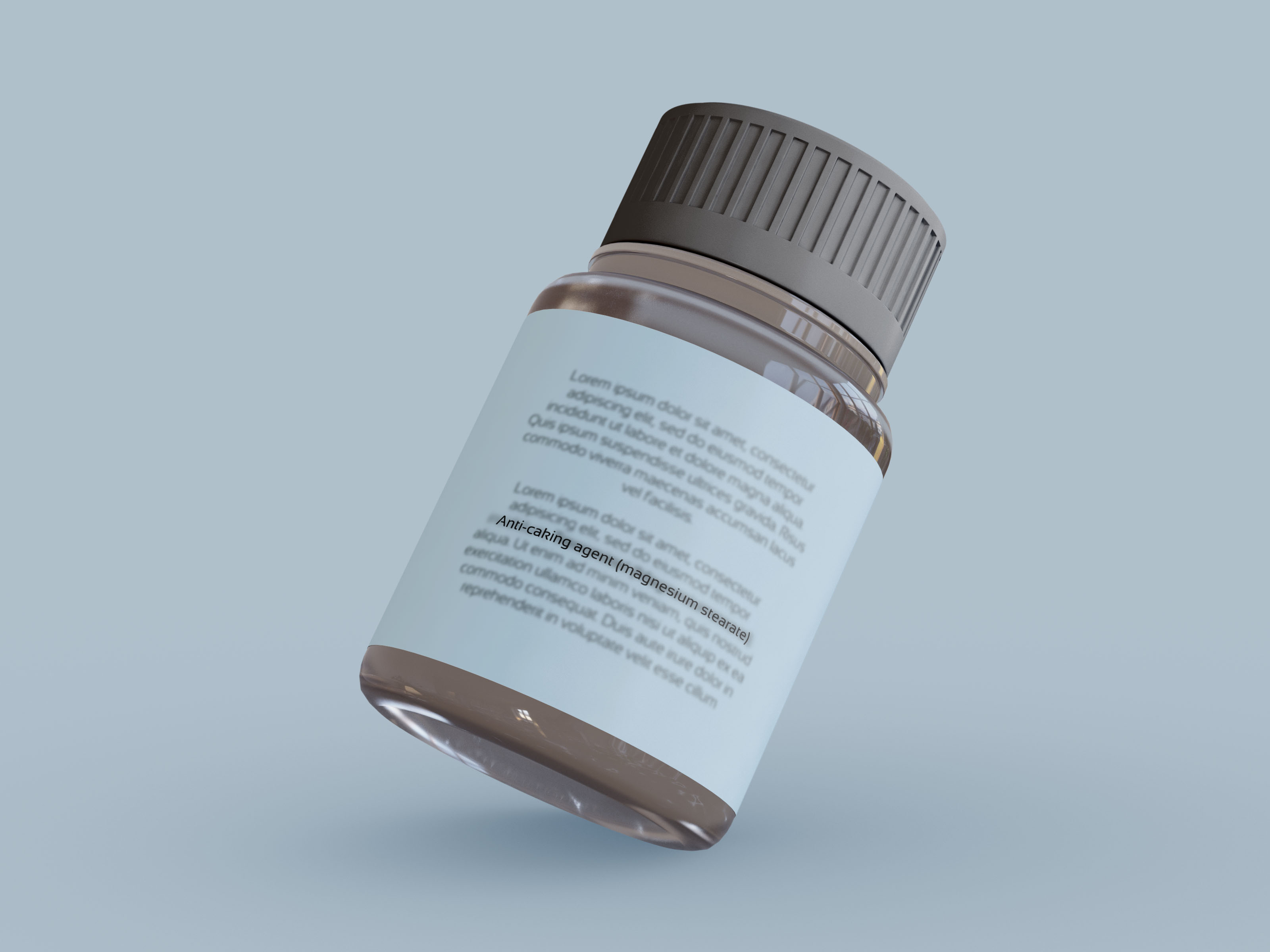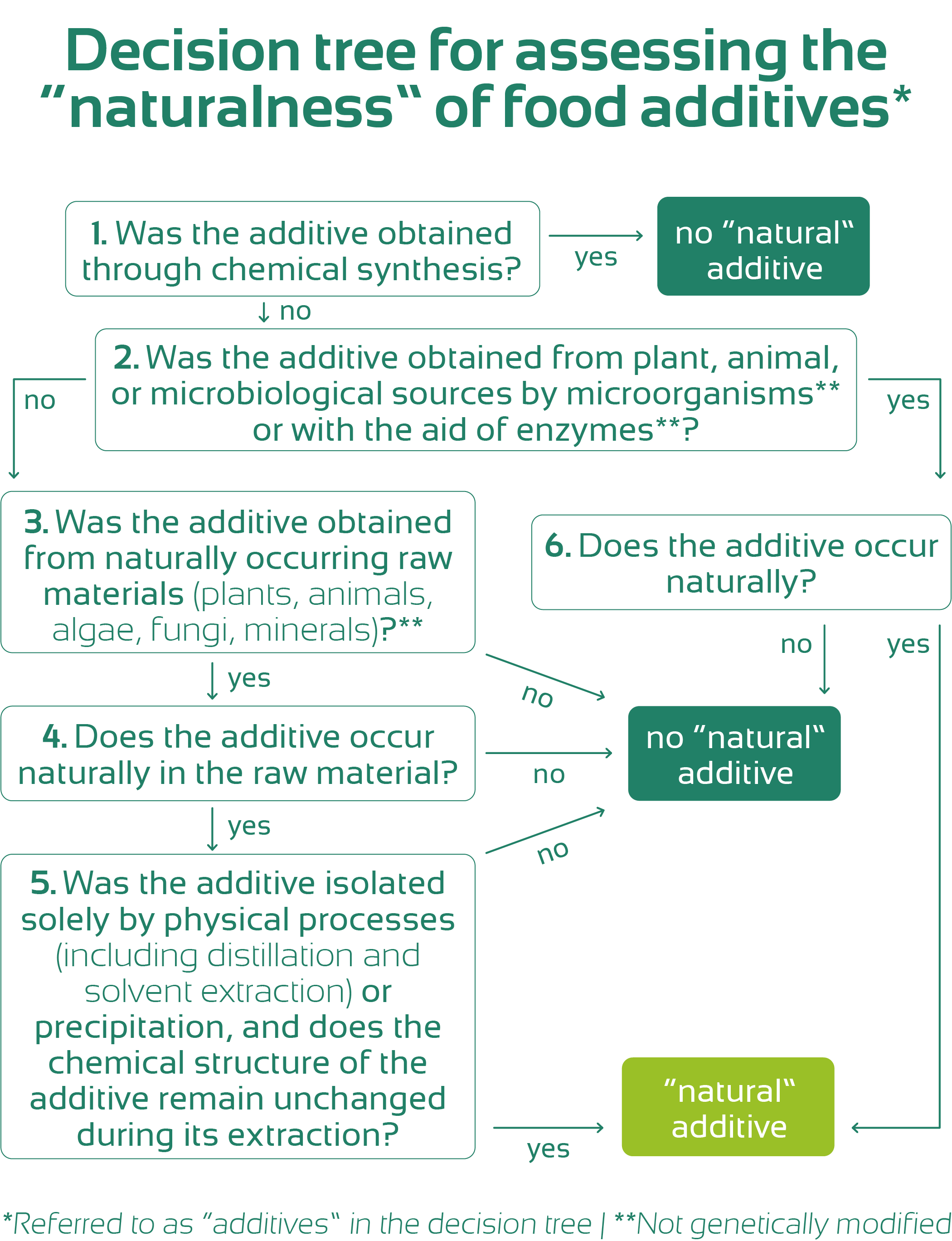Ingredients |

What exactly are food additives?
Additives are substances that are added to food for technological reasons - for example, to prevent powders from clumping together or to keep tablets in shape. It doesn't matter whether they have nutritional value or not. The important thing is that they should fulfill a specific function during production, processing or storage.
This is all regulated in EU Regulation (EC) No. 1333/2008, which specifies which additives are permitted for the various food categories and the maximum quantities. Each approved substance is given a so-called E number - for example, magnesium stearate is known as E 470b. If such a substance is used, this must be stated in the list of ingredients, always with its technological function and either the name or the E number.
However, there are two exceptions:
Carry-over: If an additive is introduced as a component of an ingredient (e.g. as an anti-caking agent in salt), it no longer has to be declared separately if it no longer has any technological effect in the end product. A well-known example of this is silicon dioxide or sodium ferrocyanide as an anti-caking agent in salt. The additive must be stated on the salt packaging, but if the salt is used in a ready-made soup, for example, the declaration “salt” is sufficient.
Processing aids: Although these are used in the production process, they are practically no longer present in the finished product because they have been removed, apart from unavoidable residues. One example is gelatine in juice or wine clarification - this explains why many juices and wines are not vegan.
Silicon dioxide, magnesium stearate and microcrystalline cellulose
Properties in focus
Magnesium stearate - the lubricant and release agent for tablets
Magnesium stearate - also known as the magnesium salt of stearic acid - ensures that powder does not stick in our machines. It acts like a lubricant and gives tablets a smooth surface. It also improves flowability: the flowability of some powders is so poor that the powder can only be processed if its flowability is improved, for example by using magnesium stearate.
Important: If it is mixed in for too long, the product can “smear” - the tablets then become crumbly.
Microcrystalline cellulose (MCC) - the filler with structure
MCC is obtained from plant fibers and is an indigestible dietary fiber. Its main task: filling. MCC is particularly important for products with a very small amount of active ingredient (e.g. vitamin K) so that the capsules reach the minimum fill level.
With tablets, on the other hand, the right “consistency” is more important: MCC can have different properties depending on the manufacturing method and particle size, which is why it is important to use a raw material with good plastic deformability for tablets, for example. MCC with properties that are too elastic can lead to problems such as “capping” in tablets. “Capping” describes a process in which the upper part of the tablet detaches horizontally. For capsules, however, a more elastic variant of MCC can be used.
Silicon dioxide - the powder remains loose
Silicon dioxide acts as a release agent and prevents powder from clumping together - whether in the sachet, in the capsule or during tablet pressing. It makes the powder more “flowable”, which is extremely important for the machines and the quality of the end products. The stability and smoothness of a tablet is also improved by the use of silicon dioxide.
❌ "Additives are unnecessary"
✅ Additives are added to products for a technological reason. They therefore always serve a purpose. For this reason, there are no “unnecessary” additives. Depending on the product, it may be necessary to use additives, e.g. to prevent clumping, to make powders compressible or to increase flowability so that the products can run on machines.
❌ "Tablets can generally always be produced without silicon dioxide, magnesium stearate, MCC and co."
✅ Only in a few cases - for example calcium carbonate in granular form. However, for most raw materials, especially raw material mixtures in which different particle sizes and types are present, excipients such as MCC, magnesium stearate or silicon dioxide are required to obtain a sufficiently hard, stable tablet whose powder does not stick to the machine parts and which reaches the consumer undamaged.
❌ "You can always do without release agents in capsules."
✅ It all depends on the powder. Fine, poorly flowing powders can clog machines or lead to weight fluctuations. With hygroscopic powders in particular, the absence of a release agent can have a negative effect on stability. The powder solidifies more quickly in the capsule and color changes can occur - a possible reason for complaints from the end customer. Accordingly, there may be powder blends that require the use of a release agent if they are to be encapsulated.
❌ "Magnesium stearate, MCC and silicon dioxide are harmful to health."
This is also a common accusation - but one that has not been confirmed:
✅ Magnesium stearate is broken down by the body into fatty acids and magnesium and processed quite normally. The European Food Safety Authority (EFSA) has not identified any safety concerns. The alleged adverse health effects of magnesium stearate are often based on the results of individual studies, the applicability of which to humans is often questionable. For example, the belief that magnesium stearate has a negative effect on the immune system is based on a 1990 study in which immune cells from mice were bathed in stearic acid. However, as the immune cells of mice react very differently to those of humans and the quantities of stearic acid used were many times higher than can be achieved with normal consumption, this study has already been refuted.
✅ In the case of microcrystalline cellulose, the majority of consumer concerns relate to the fact that MCC particles smaller than 5 micrometers (nanoparticles) can pass through the intestinal wall. As the body does not metabolize them, the consequences for health are unclear. EFSA last re-evaluated MCC in 2018. It found that the majority of particles used in the industry are between 10 and 100 micrometres in size. The EFSA also explained that cellulose particles expand in water and it is therefore very unlikely that nanoparticles are still present when the food reaches the intestine.
✅ Concerns about silicon dioxide also revolve around the use of nanomaterials. Silicon dioxide with particle sizes in the nano range could be deposited in the organs and lead to problems in cell metabolism. EFSA re-evaluated silicon dioxide in 2024 and also assessed exposure to nanoscale silicon dioxide particles compared to the previous assessment from 2018. EFSA came to the conclusion that there are no safety concerns for silicon dioxide in all population groups in the typical quantities and areas of use.

The Working Group of Food Chemists (ALS) has addressed the question of when a food additive may be advertised as natural. According to the ALS, although there is no distinction between “artificial” and ‘natural’ additives in the laws themselves, there is nevertheless a common understanding of what constitutes a “natural” additive. The ALS has therefore created a decision tree that can be used to determine whether a food additive is artificial or natural.
If an additive is obtained through chemical synthesis, it cannot normally be considered “natural,” even if it also occurs naturally in nature. One example of this is the chemically produced orange-red dye canthaxanthin (E161g), which is also found naturally in crabs and flamingo feathers, but cannot be considered natural because it is produced by chemical synthesis. An exception to this rule is the colorant vegetable carbon (E153). Although this is obtained through incomplete combustion, which formally meets the definition of chemical synthesis, it is considered “natural” due to its traditional history of use (e.g., in naturopathy), deviating from the decision tree.
If genetically modified microorganisms or genetically engineered enzymes are used in the biotechnological synthesis (use of enzymes or microorganisms in production) of an additive, the additive obtained can no longer be considered “natural.” If an additive has been obtained by a biotechnological process, it can only be classified as “natural” if it also occurs in nature.
If the additive has not been produced by a chemical or biotechnological process, it can only be considered “natural” if it has been obtained from raw materials occurring in nature (animals, plants, fungi, algae, minerals), occurs naturally in the raw material, and has been isolated only by physical processes (including extraction and distillation) or precipitation in such a way that its natural chemical structure is retained during extraction or that only a structural change to another derivative occurring naturally in significant quantities in the raw material occurs during production. For example, the green pigment chlorophyll (E140(i)) can be considered natural, but the green pigments chlorophyllins (E140(ii)), copper complexes of chlorophylls (E141(i)) and copper complexes of chlorophyllins (E141(ii)) cannot be considered natural because they have undergone structural changes that do not occur in nature.
Sources (as of 10.04.2025):
- Re-evaluation of sodium, potassium and calcium salts of fatty acids (E 470a) and magnesium salts of fatty acids (E 470b) as food additives - - 2018 - EFSA Journal - Wiley Online Library
- Re-evaluation of celluloses E 460(i), E 460(ii), E 461, E 462, E 463, E 464, E 465, E 466, E 468 and E 469 as food additives - - 2018 - EFSA Journal - Wiley Online Library
- Re-evaluation of silicon dioxide (E 551) as a food additive in foods for infants below 16 weeks of age and follow-up of its re-evaluation as a food additive for uses in foods for all population groups - - 2024 - EFSA Journal - Wiley Online Library




